Transforming Organic Traffic into Donors: A Nonprofit SEO Success Story
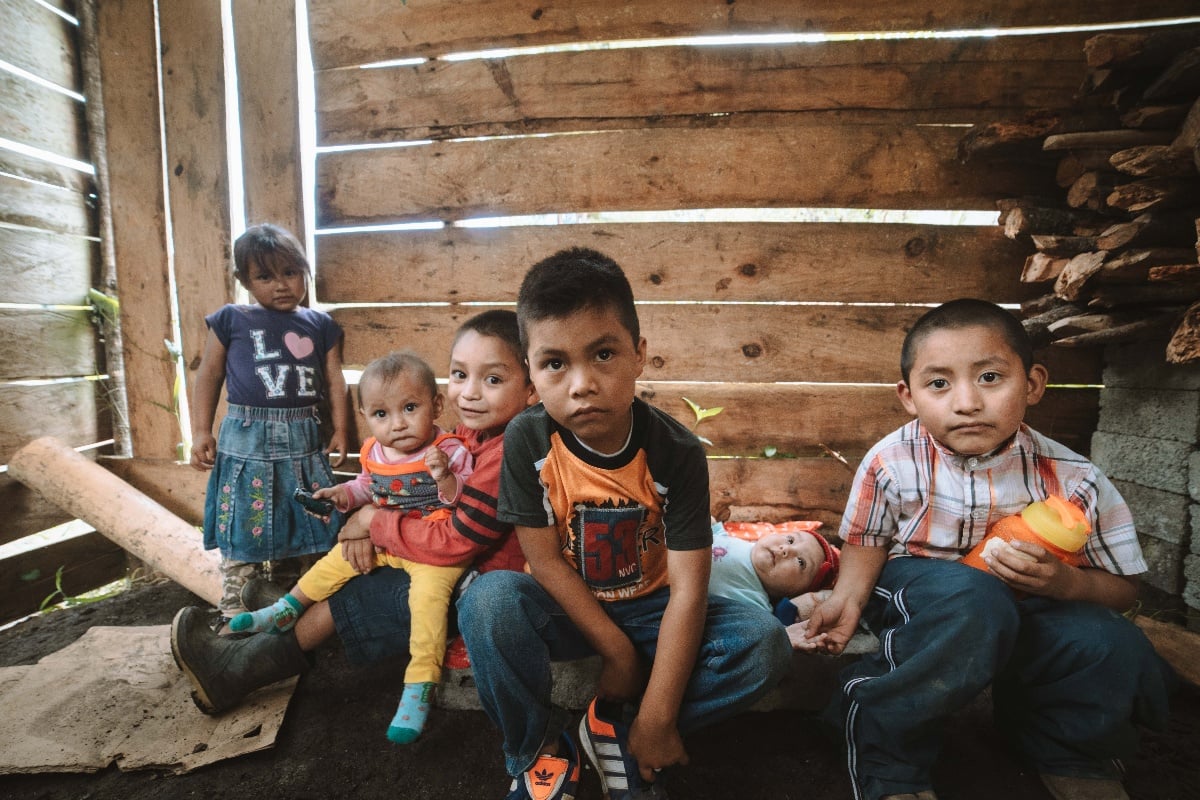
Sometimes, spikes in traffic and keywords occur out of the blue. Whether there’s a news story related to an area your organization serves or a holiday coming up that means a lot to your community, seeing sudden increases in engagement is one of the fun parts of playing the SEO game.
This happened to us a few years ago.
One of our clients was experiencing record organic growth, which occurred outside of the current fundraising campaign we were running.
After a quick investigation, we discovered that two of our evergreen content resources had quickly started to rank on the first page of Google’s organic search results and were now generating a significant amount of traffic.
Over the years, we have achieved success in creating prayer-based digital devotionals for faith-based nonprofits. In this context, we recently developed a new Lenten Prayer Devotional for our client, Missionhurst, and made slight updates to their Easter Devotional.
.png?width=720&height=206&name=unnamed%20(1).png)
I didn’t realize it at the time, but the growth that we were experiencing was the start of an SEO inflection point—the moment you finally start to see an uptick in organic growth from your content efforts.
Above is a screenshot of our client’s ranking keywords on Google search for that year. As you can see, there is a clear “inflection point” where their keywords increase.
Connecting Organic Traffic To Our Nonprofit Fundraising Strategies
All this free growth was exciting, but we wanted to find a way to apply this to our nonprofit fundraising strategies to acquire new donors.
Each of our ranking evergreen content resources was gated by a form, which required the user to download the resource in exchange for providing their contact information and opting in to future communications.
To connect these new prospects to our child sponsorship campaign for our client's MercyWorks initiative, we decided to leverage HubSpot’s marketing automation tools and create a simple email series. These emails introduced all new users sourced from these evergreen resources to our current fundraising campaign.
You know what happened?
These new visitors from organic search ultimately became new donors.
Transforming Anonymous Website Visitors Into Real Donor Cultivation Opportunities
Especially in the nonprofit industry, it is challenging for organizations to envision what a content foundation for their nonprofit can look like and how it can nurture prospective donors into supporting their specific missions. This becomes even more challenging when development directors are trying to convince board members of its importance.
To help explain, here is a visual story of how an actual donor named Matt found one of our clients (via Google search), consumed their content, and then decided to change the life of a child in the Philippines by becoming a child sponsor—the goal of our client’s fundraising campaign.
Step #1: Optimize Content For SEO and Google Search
Every time you create a landing page or blog post, you should have a specific set of keywords that you are targeting and strategically using in particular locations on your webpage, such as H1 tags, image alt tags, etc. When done well (and taking into account other variables like external links, user time on webpage, etc.), your Google search rankings will improve.
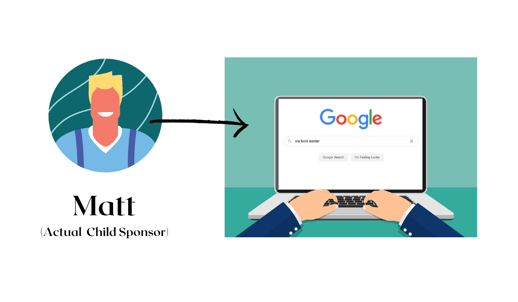
Here’s how it worked for Matt: He began his digital donor journey when he searched on Google for “Via Lucis Easter.” Because our team spends time optimizing our landing pages and blog posts, one of our clients’ blog posts was ranked on the first page of Matt’s Google search query results. This post highlights our client's Via Lucis Easter Devotional Digital Resource — a prayer-based guide that we crafted with the knowledge that it would resonate with their specific audience.
Explore our blog—SEO for Nonprofits: 4 Tips to Improve Your Rankings and Grow Your Organic Traffic—to learn more about strategically optimizing your content.
Step #2: Leverage Gated Content For Donor Acquisition
Once a user arrives at your website from organic search, you need to provide them with something to do or with something of value. For many of our clients, we craft custom digital resources that prospective donors find relevant and compelling—so compelling that they voluntarily submit their contact information and agree to receive future communications from the nonprofit.
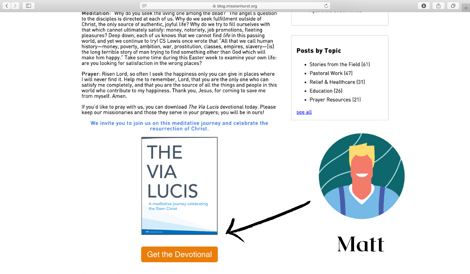
When Matt landed on the blog post, he discovered that there was a digital resource entirely dedicated to the Via Lucis, the prayer topic he was interested in. Matt provided our nonprofit with his first and last name, email, and received the digital resource.
Step #3: Engage New Prospects with a Welcome Email Series and Targeted Content Offers
Depending on the channel from which a new contact comes, we generally recommend that nonprofits enroll a prospective donor in a specific welcome email series consisting of similar, related content offers.
In this example, Matt has an affinity for prayer resources, so we sent him an email thanking him for downloading the Via Lucis prayer devotional. We then followed up with an email containing additional prayer resources in case he was interested.
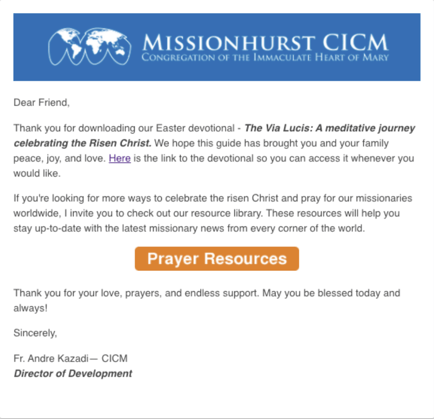
Step #4: Nurture Prospective Donors with a Campaign-Specific Workflow
If you were to analyze Matt’s behavior over the next two weeks, you would find that it was anything but linear.
After we sent Matt the aforementioned email, he browsed the prayer resources. He would periodically visit other pages on our client’s website, both opening emails and reading content, but never clicking on a link.
However, once we sent Matt a campaign-specific email, he decided to take a bigger step in his support of our client’s campaign fundraising initiative by clicking on the email’s primary CTA: “Sponsor a Child.”
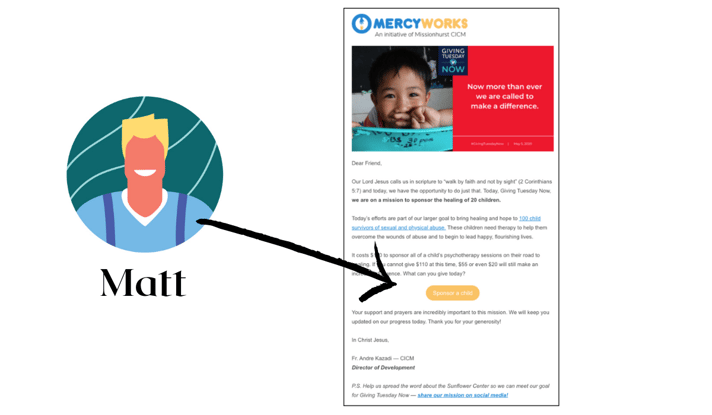
Step #5: Have a Fundraising Landing Page With a Clear “Ask”
On the same day that we sent the campaign-specific email, Matt clicked the email CTA, read the landing page, and sponsored a child’s healing from sexual and physical abuse in the Philippines.

The copy on our landing page not only matched the email copy, but it was also very clear about what the need was and how his donation would impact the children who’ve suffered from abuse.
How to Build a Nonprofit Content Marketing Strategy That Drives Donor Engagement
Matt’s entire digital journey from discovery to financial support took about 2.5 weeks.
This nurturing process can and should look different for each of your supporters depending on their digital habits. You need to be able to meet donors where they are.
The question is: do you have a marketing system that is flexible enough to adjust to people's digital preferences, while also enabling you to pivot and connect your campaigns to various trends as you discover them?
It should be noted that throughout the 2.5 weeks, our team did not have to undertake any additional work to encourage Matt to make a donation. Everything was preprogrammed, automated, and specifically planned to work based on the individual user's behavior.
Imagine the same thing happening, but instead of one person donating, 100 people donating. Imagine what you could do by scaling this nonprofit marketing effort.
Creating this system requires time, and several steps are involved in building its foundation. However, there are several principles or lessons to keep in mind if you want to develop a process that allows you to quickly pivot and automate the nurturing of prospective donors into lifelong advocates.
Lesson #1: Build A SEO Content Strategy With Nonprofit Storytelling
At the heart of each brand is a good story, and it is your nonprofit’s job to make sure that you’re inviting your constituents into that story.
Most of our donor acquisition campaign strategies focus on building quality content that leverages storytelling and devotion-based resources.
To start engaging with the next generation of donors, you need to think about two things:
#1— What are your best stories? (and what’s the best medium through which to tell them?)
#2— What resources should your nonprofit create to delight prospective and current donors?
It is imperative to think about the kinds of content you can create to get your constituents to fall in love with your brand over and over again, whether it’s the first time that they are hearing about your nonprofit or their 30th donation.
Lesson #2 — Reduce Friction and Audit Your Content Pathways
Consider your website as a revenue accelerator.
If your organization’s website is not providing you with a solid stream of revenue, you need to answer why and where.
Most likely (as is the case for many nonprofits), you have many points of friction on your website that reduce your ability to generate new contacts and donations.
You can think of friction as anything disruptive to the user experience.
For example, dead links, low resolution/very pixelated photos, bad design or obnoxious branding, a navigation menu that doesn’t make sense, not offering a mobile wallet donation option, etc.—these are all areas that slow down revenue generation for your nonprofit.
If you were to focus on improving the user experience and making it very easy for a user to navigate your website, you would find that it is much more likely you’ll drive users to do what you want them to do—subscribe to your newsletter, download a prayer resource, or even donate.
A practical approach to this is to list all the actions you want a user to take and then work backwards to see how you can guide them to take that specific action.
For example, if you want your users to download a devotional resource, you should identify the different ways a user can access the page on which this resource is housed. If you were promoting a landing page, a user could access that page through an email promotion, a social media post, through your homepage, or a blog post. You must audit your content pathways to ensure that there is a clear avenue for users to find your content piece and that all possible points of friction are removed.
One thing we always like to stress: If it doesn’t make sense to you, the owner of the website, it won’t make sense to your users.

Creating a frictionless experience also relies on providing the user with the necessary information when they are most interested—before they even ask for it!. If you build a content foundation on a powerful marketing platform like HubSpot, you can automate communications in a way that is both scalable and personal. This will make your nonprofit fundraising a lot easier.
Lesson #3 — Constantly Monitor Your Website Trends and Organic Traffic
As you can probably guess, after this experience, I started spending the beginning and end of each week looking at my client’s latest website trends, keeping my eyes peeled for anything that I could leverage for more donations or conversions.
From a practical level, you should know your own website’s top landing pages and which channels are generating the most organic traffic to these pages.
Not only can you then figure out how to connect that traffic to your current or evergreen campaigns, but you're also able to see what works and what doesn't constantly.
Chances are, you have 2 to 3 sources that are providing the most significant share of your ROI, while 3 or 4 other channels are taking up most of your time without providing much revenue. If you can recognize these areas, you’ll be able to focus your energy on what matters for the bottom line, transforming your website into a revenue accelerator rather than a friction-filled digital space.
Differentiate Your Nonprofit
It’s important to mention that in the nonprofit space, many different organizations are doing very similar work (at least to prospective donors). It’s come to the point where it can be difficult to distinguish one nonprofit’s mission from another’s.
As more and more nonprofits establish a stronger digital presence, those that can create solid content foundations with engaging branding will be best positioned to capture the donor market. In the next few years, it’s going to be essential that nonprofits learn how to differentiate themselves while also taking the time to develop strategies for marketing automation that allow them to scale.
Looking for strategic insights and latest trends in the nonprofit space? Subscribe to our blog today!
Want help making your nonprofit stand out from the rest? We’d love to connect with you!


